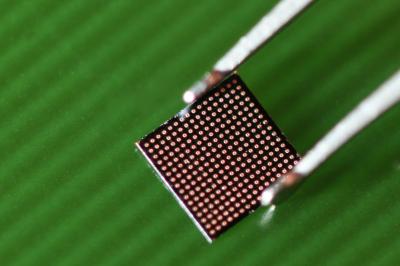Scientists Are Stacking Processor Cores on Top of Each Other
Future microprocessors could extend the idea of 3D transistors to entire 3D cores.
Scientists at the Ecole Polytechnique Fédérale de Lausanne (EPFL) said they have developed a chip that can integrate three or more processors that are stacked on top of each other. Today's processing cores are aligned horizontally.
According to Yusuf Leblebici, director of the Microelectronics Systems Laboratory (LSM) at EPFL, the processors are vertically connected through "several hundreds" of "very thin copper microtubes", commonly referred to as Through-Silicon-Vias (TSVs). "It's the logical next step in electronics development, because it allows a large increase in terms of efficiency," Leblebici said. He noted that more than 900 TSVs are "functioning simultaneously".
"This superposition reduces the distance between circuits, and thus considerably improves the speed of data exchange," added Yuksel Temiz, a researcher at LSM.
While presented at the 2012 Interconnection Network Architectures Workshop in Paris, Leblebici did not reveal further features of the technology, but noted that it is not ready for mass-production. At this time, he wants to make his research available to "a number of academic research teams for further development, before being commercialized."
Get Tom's Hardware's best news and in-depth reviews, straight to your inbox.

Douglas Perry was a freelance writer for Tom's Hardware covering semiconductors, storage technology, quantum computing, and processor power delivery. He has authored several books and is currently an editor for The Oregonian/OregonLive.
-
mayankleoboy1 waiting for the time when these "still academic, not ready for production" technologies do get ready for mass-production....Reply -
thezooloomaster This sounds a lot like the 3D microchips that Kurzweil said would be the next step in sticking true to Moore's law.Reply -
americanbrian My only concern is that the heating effects will be increasingly difficult to manage. Clocking down the chips may be the only way to get them to not overheat, which will still be ok I guess but you lose single threaded speed for presumably higher core counts.Reply
We already see that this approach has been a mixed success on our desktops. It is kind of exciting though. It is like the Terminator 2 brain chip. -
Dangi this is the natural upgrade path to improve processors. increasing it's area isn't effective due to the long distances that comes with a bigger chip.Reply
Heat may no be a real problem, IBM some time ago design a new system to cool chips by creating nanotubes inside the cheap and running water throught it, creating a "true" watercooling system.
More info abouts this nanotubes in the following link
http://www-03.ibm.com/press/us/en/pressrelease/32049.wss -
Yargnit I wonder what sort if difficulties this may cause with cooling the cores not directly adjacent to the heat sync?Reply -
joytech22 Well cooling would be a HUGE problem wouldn't it? Unless they use the outer edge of the cores as the thermal dissipation thing, and dissipate heat through a huge plate covering all four edges, which further extends to a larger heatsink of some sort?Reply
Or did I just solve the problem for them..?
I don't know.. eh -
Shaun o How about making a sealed chamber around the stacked chips with a non conductive fluid/ mineral oil passing through all of the stacked chips with as you said, small heat sinks on the outer four edges. and pump it around.Reply -
tomsreader what about the cooling? if it's stacked then the lower core will get higher temperatures compared to the one closer to the IHSReply -
C12Friedman I can't wait for my 48 core processor, oh, it's not out yet? What am I to do in the meantime?Reply
